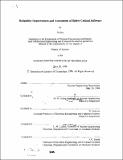Reliability improvement and assessment of safety critical software
Author(s)
Sui, Yu, 1973-
DownloadFull printable version (4.368Mb)
Advisor
Michael W. Golay and Daniel Jackson.
Terms of use
Metadata
Show full item recordAbstract
In order to allow the introduction of safety-related Digital Instrumentation and Control
(DI&C) systems in nuclear power plants, the software used by the systems must be demonstrated
to be highly reliable. The most widely used and most powerful method for ensuring high software
quality and reliability is testing. An integrated methodology is developed in this thesis for
reliability assessment and improvement of safety critical software through testing. The
methodology is based upon input domain-based reliability modeling and structural testing
method. The purpose of the methodology is twofold: Firstly it can be used to control the testing
process. The methodology provides path selection criteria and stopping criteria for the testing
process with the aim to achieve maximum reliability improvement using available testing
resources. Secondly, it can be used to assess and quantify the reliability of the software after the
testing process. The methodology provides a systematic mechanism to quantify the reliability and
estimate uncertainty of the software after testing.
Description
Thesis (S.M.)--Massachusetts Institute of Technology, Dept. of Nuclear Engineering; and, (S.M.)--Massachusetts Institute of Technology, Dept. of Electrical Engineering and Computer Science, 1998. Includes bibliographical references (leaves 95-101).
Date issued
1998Department
Massachusetts Institute of Technology. Department of Nuclear Science and Engineering; Massachusetts Institute of Technology. Department of Electrical Engineering and Computer SciencePublisher
Massachusetts Institute of Technology
Keywords
Nuclear Engineering, Electrical Engineering and Computer Science